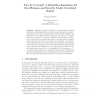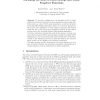49 search results - page 3 / 10 » A Feebly Secure Trapdoor Function |
IWSEC
2009
Springer
13 years 11 months ago
2009
Springer
Reducing the minimum assumptions needed to construct various cryptographic primitives is an important and interesting task in theoretical cryptography. Oblivious Transfer, one of ...
TCC
2010
Springer
14 years 2 months ago
2010
Springer
A family of trapdoor functions is one-way under correlated inputs if no efficient adversary can invert it even when given the value of the function on multiple correlated inputs. T...
PKC
2012
Springer
11 years 7 months ago
2012
Springer
We initiate the study of security for key-dependent messages (KDM), sometimes also known as “circular” or “clique” security, in the setting of identity-based encryption (I...
CRYPTO
1997
Springer
13 years 9 months ago
1997
Springer
We present a new proposal for a trapdoor one-way function, from which we derive public-key encryption and digital signatures. The security of the new construction is based on the ...
ACNS
2010
Springer
13 years 10 months ago
2010
Springer
To this day, realizations in the standard-model of (lossy) trapdoor functions from discrete-log-type assumptions require large public key sizes, e.g., about Θ(λ2 ) group elements...


